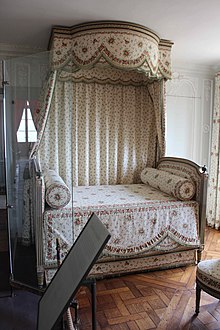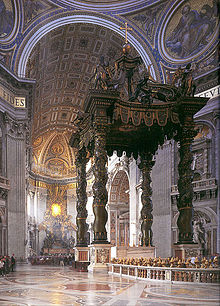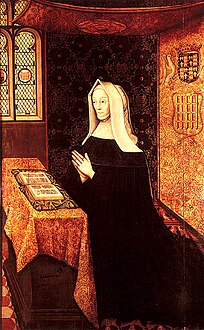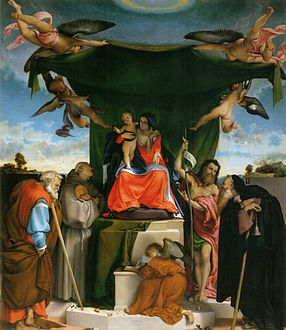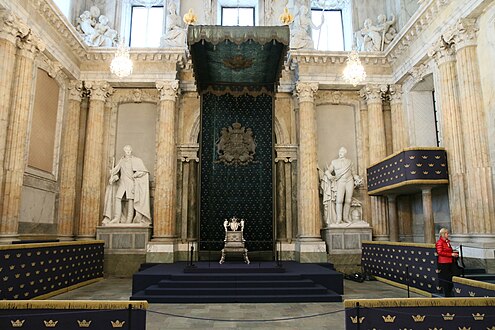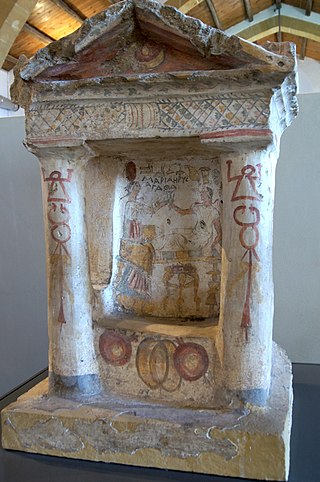
In ancient Roman religion, an aedicula is a small shrine, and in classical architecture refers to a niche covered by a pediment or entablature supported by a pair of columns and typically framing a statue, the early Christian ones sometimes contained funeral urns. Aediculae are also represented in art as a form of ornamentation.

Gian LorenzoBernini was an Italian sculptor and architect. While a major figure in the world of architecture, he was more prominently the leading sculptor of his age, credited with creating the Baroque style of sculpture.

The Papal Basilica of Saint Peter in the Vatican City, or simply Saint Peter's Basilica, is a church of the Italian High Renaissance located in Vatican City, an independent microstate enclaved within the city of Rome, Italy. It was initially planned in the 15th century by Pope Nicholas V and then Pope Julius II to replace the ageing Old St. Peter's Basilica, which was built in the fourth century by Roman emperor Constantine the Great. Construction of the present basilica began on 18 April 1506 and was completed on 18 November 1626.

A papal coronation is the formal ceremony of the placing of the papal tiara on a newly elected pope. The first recorded papal coronation was of Pope Nicholas I in 858. The most recent was the 1963 coronation of Paul VI, who soon afterwards abandoned the practice of wearing the tiara. To date, none of his successors have used the tiara, and their papal inauguration celebrations have included no coronation ceremony, although any future pope may elect to restore the use of the tiara at any point during his pontificate.

A throne is the seat of state of a potentate or dignitary, especially the seat occupied by a sovereign on state occasions; or the seat occupied by a pope or bishop on ceremonial occasions. "Throne" in an abstract sense can also refer to the monarchy itself, an instance of metonymy, and is also used in many expressions such as "the power behind the throne".

A cathedra is the raised throne of a bishop in the early Christian basilica. When used with this meaning, it may also be called the bishop's throne. With time, the related term cathedral became synonymous with the "seat", or principal church, of a bishopric.

A throne room or throne hall is the room, often rather a hall, in the official residence of the crown, either a palace or a fortified castle, where the throne of a senior figure is set up with elaborate pomp—usually raised, often with steps, and under a canopy, both of which are part of the original notion of the Greek word thronos.
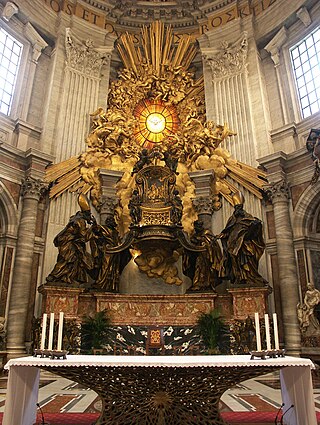
The Chair of Saint Peter, also known as the Throne of Saint Peter, is a relic conserved in St. Peter's Basilica in Vatican City, the sovereign enclave of the Pope inside Rome, Italy. The relic is a wooden throne that tradition claims belonged to the Apostle Saint Peter, the leader of the Early Christians in Rome and first Pope, and which he used as Bishop of Rome. The relic is enclosed in a sculpted gilt bronze casing designed by Gian Lorenzo Bernini and constructed between 1647 and 1653. In 2012, Pope Benedict XVI described the chair as "a symbol of the special mission of Peter and his Successors to tend Christ's flock, keeping it united in faith and in charity."

The Solomonic column, also called barley-sugar column, is a helical column, characterized by a spiraling twisting shaft like a corkscrew. It is not associated with a specific classical order, although most examples have Corinthian or Composite capitals. But it may be crowned with any design, for example, making a Roman Doric solomonic or Ionic solomonic column.

St. Peter's Baldachin is a large Baroque sculpted bronze canopy, technically called a ciborium or baldachin, over the high altar of St. Peter's Basilica in Vatican City, the city-state and papal enclave surrounded by Rome, Italy. The baldachin is at the center of the crossing, and directly under the dome of the basilica. Designed by the Italian artist Gian Lorenzo Bernini, it was intended to mark, in a monumental way, the place of Saint Peter's tomb underneath. Under its canopy is the high altar of the basilica. Commissioned by Pope Urban VIII, the work began in 1623 and ended in 1634. The baldachin acts as a visual focus within the basilica; it is itself a very large structure and forms a visual mediation between the enormous scale of the building and the human scale of the people officiating at the religious ceremonies at the papal altar beneath its canopy.

The altar in the Catholic Church is used for celebrating the Sacrifice of the Mass.

In ecclesiastical architecture, a ciborium is a canopy or covering supported by columns, freestanding in the sanctuary, that stands over and covers the altar in a church. It may also be known by the more general term of baldachin, though ciborium is often considered more correct for examples in churches. Really a baldachin should have a textile covering, or at least, as at Saint Peter’s in Rome, imitate one. There are exceptions; Bernini's structure in Saint Peter's, Rome is always called the baldachin.

The Royal Nine-Tiered Umbrella is considered the most sacred and ancient of the royal regalia of Thailand. A royal umbrella consists of many tiers, five for the prince, seven for the crown prince and unconsecrated king, and nine for a fully sovereign and crowned Thai king. Until the coronation rites are completed, the new king will not be able to sit on the throne under the nine-tiered umbrella.

The Church of the Val-de-Grâce is a Roman Catholic church in the 5th arrondissement of Paris. The church was built as part of a royal abbey by Anne of Austria, the Queen of France, to celebrate the birth of her son, Louis XIV in 1638. Construction began in 1645 under the direction of architect François Mansart and was completed in 1665 by Gabriel Le Duc. The abbey and church were turned into a hospital during the French Revolution and then became part of the Val-de-Grâce Hospital, which closed in 1979. The church is attached to the diocese of the French military and is open to visitors at specified hours. Its dome is a landmark in the skyline of Paris.
Italian Baroque interior design refers to high-style furnishing and interior decorating carried out in Italy during the Baroque period, which lasted from the early 17th to the mid-18th century. In provincial areas, Baroque forms such as the clothes-press or armadio continued to be used into the 19th century.

The Scottish royal tapestry collection was a group of tapestry hangings assembled to decorate the palaces of sixteenth-century kings and queens of Scotland. None appear to have survived.

Dornix, also known as dornicks and darnacle, is name used for woollen and linen fabrics, first used in the 16th century.
Bed hangings or bed curtains are fabric panels that surround a bed; they were used from medieval times through to the 19th century. Bed hangings provided privacy when the master or great bed was in a public room, such as the parlor, but also showed evidence of wealth when beds were located in areas of the home where. They also kept warmth in, and were a way of showing one's wealth. When bedrooms became more common in the mid-1700s, the use of bed hangings diminished.

Furniture and furnishings in early modern and late medieval Scotland were made locally or imported, mostly from Flanders and France. Although few pieces of furniture survive from the early part of the period, a rich vocabulary and typology is preserved in inventories and wills. This documentary evidence in the Scots language details the homes of the wealthy and aristocratic. Textiles and beds belonging to Mary, Queen of Scots are very well documented. Scottish wooden furniture was often carved with the initials of married couples.

